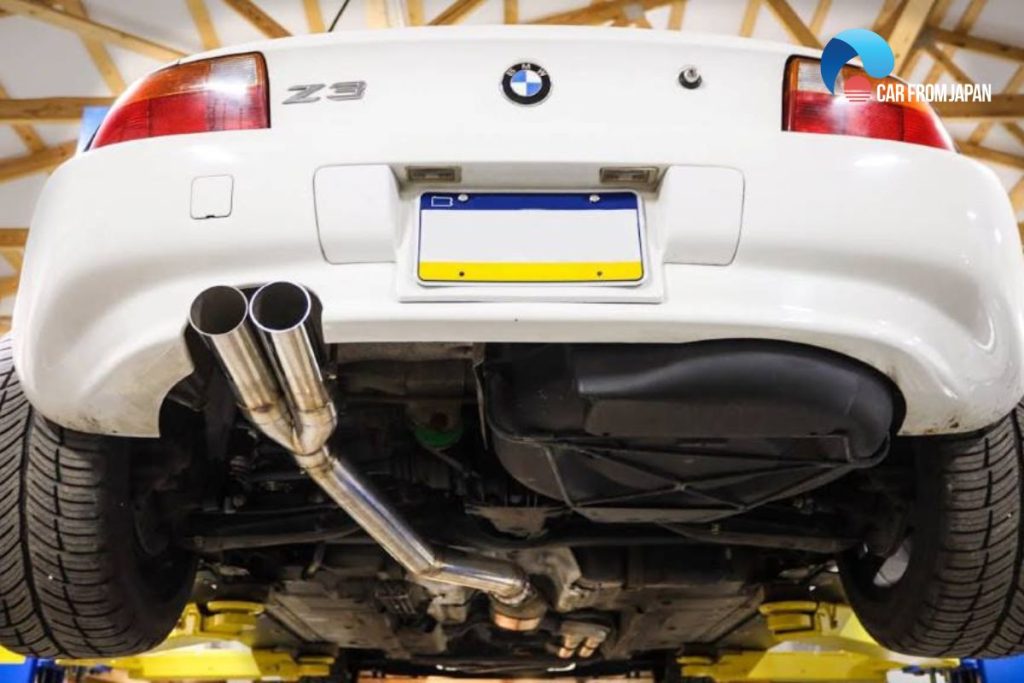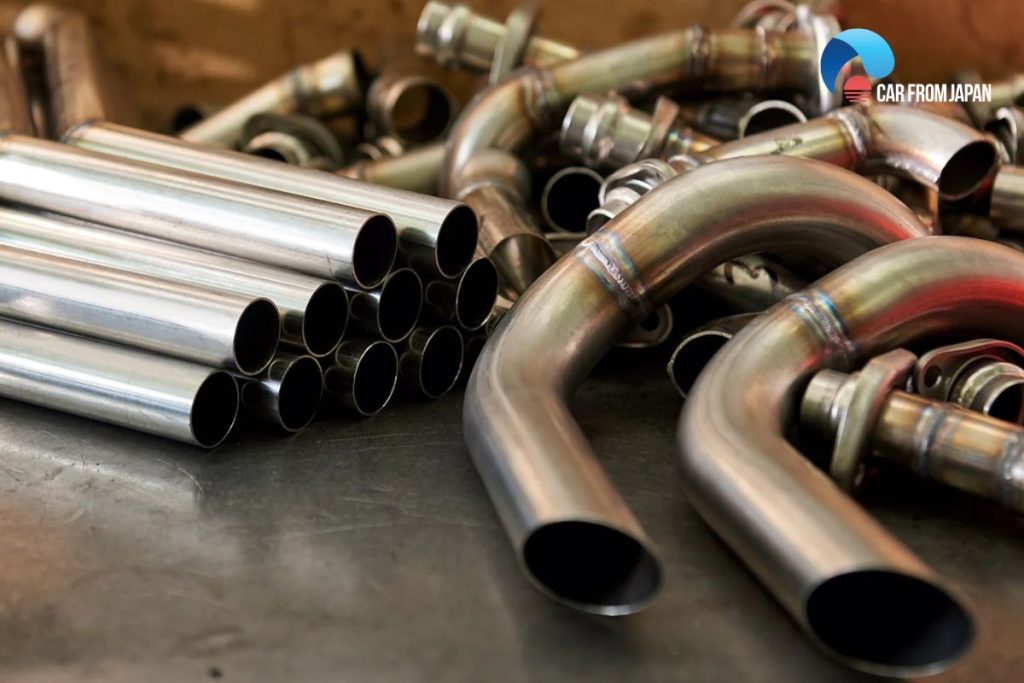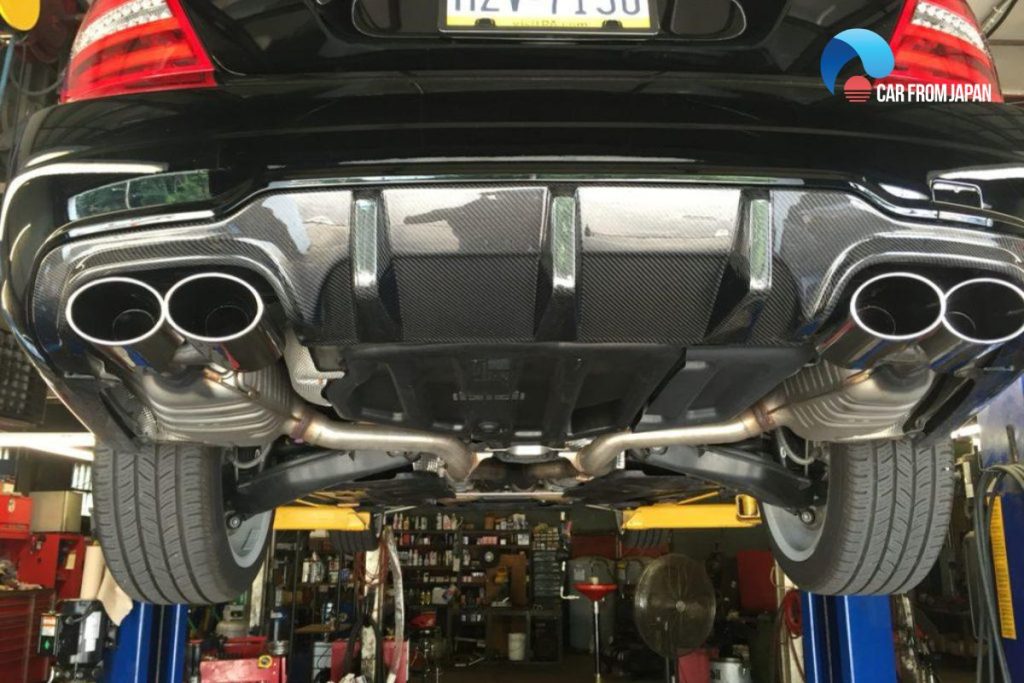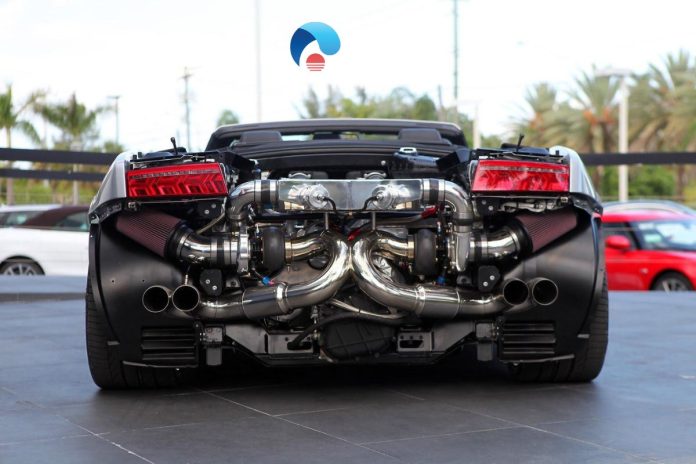This article covers everything you need to know about straight pipe exhaust, exploring the pros, cons, legality, and practical implications of this modification.
Whether you’re considering straight piping your own car or are simply curious, this guide will provide the knowledge you need to make an informed decision.
Contents
What Are Straight Pipes?
That roar as you accelerate – the sound of your car’s exhaust – can be a source of pride for car enthusiasts. And when it comes to making their cars louder, many choose to straight pipe them.
Some love the loud, aggressive sound and the potential performance boost, while others hate the excessive noise and worry about the environmental impact. While remaining controversial, straight pipe exhausts demand careful consideration.
So, what exactly is straight piping a car?
Straight piping a car means replacing the entire exhaust system – mufflers, catalytic converters, resonators, everything – with a single, straight pipe.
Standard exhaust systems use those components to reduce noise and emissions, making them suitable for street use.
Straight pipes, on the other hand, are typically found only on race cars driven on closed tracks because they don’t have these noise and emissions controls, making them often too loud and polluting for public roads.
Think of it this way: a straight pipe is just a straight, uninterrupted pipe from the engine’s headers to the exhaust outlet.
This unrestricted flow of exhaust gases can, when properly designed and tuned, increase horsepower and torque, which is why they’re used in racing applications.
However, for everyday driving, straight pipes have significant drawbacks. They’ll make your car much louder, potentially violating noise ordinances.
They also increase emissions, especially if the catalytic converter is removed, which is illegal for street use in most places.
This is why modern cars, designed to meet stringent emissions standards, never use straight pipe exhausts.
If you’re considering this modification, thoroughly research your local noise and emissions regulations.
Is Straight Pipe Legal?
If you are wondering is straight piping legal, here is an answer for you.
True straight pipe exhaust systems require the catalytic converter to be removed, which is prohibited in all 50 states in USA. But only if you drive your automobile on the street; the rules for track cars are quite different.
Unless you have a track-only car, straight piping it will very certainly get you in hot water with the authorities. Not to mention the obnoxiously loud exhaust tone, which will draw unwelcome attention from both the authorities and your neighbors.
You may lawfully install a straight pipe exhaust system as long as you are not driving your automobile on public roads. Whether or whether you get in trouble is entirely dependent on the jurisdiction in your area.
If you are discovered driving without a catalytic converter, you may be fined up to or even more than $10,000.
However, some governments do not rigidly enforce emission controls as others do. You might be able to get away with a straight pipe exhaust in those states.

What Are The Pros and Cons of a Straight Pipe Exhaust?
As you are completely aware of what the straight pipe exhaust is, now let’s explore the advantages and disadvantages of employing it.
Advantages
Performance increase
As mentioned above, the main reason why most car enthusiasts use this exhaust system is its high performance.
These systems help to reduce back pressure, thereby providing more power gains and better fuel economy to most cars. However, be careful when selecting the size of the pipe as it greatly affects the torque and horsepower.
Engine roar
A straight pipe exhaust system is most likely responsible for the strong sound frequently associated with racing automobiles.
Straight pipe systems are popular among automobile enthusiasts because they allow your engine to generate its loudest, most natural noises when it is not muffled by a car muffler.
Lighter vehicle
Less weight is always associated with fewer automobile parts. A lighter muffler or catalytic converter can lead to a more efficient car. Lighter cars also have a higher top speed and a little higher fuel economy.
Upgraded look
These pipe exhaust systems can be dressed and extended up with the help of chrome fittings to provide a great look as well.
While spectators won’t be able to view the full exhaust system, the sleek, metallic, and muffler-free straight pipes that protrude from the back of your straight piping car provide a personalized aesthetic that motorheads like.
If instilling your individuality into your vehicle is vital to you, mods such as straight pipes can help.

Disadvantages
These systems have many benefits yet they lack flexibility. The main drawback of these exhaust systems is the cost, as you need to tune your vehicle according to them.
In case you didn’t get the appropriate pipe size, it may make your car lose piles of low-end torque.
Environmental consequences
Straight pipes do not control or filter your car’s emissions, and so contribute directly to environmental destruction.
Standard exhaust systems do more than simply mute your vehicle’s sound; they also eliminate dangerous pollutants from the exhaust flow.
Straight pipes lack catalytic converters, which function to filter out gasses such as CO2 and sulfur, both of which may affect the earth’s environment and contribute to global warming, acid rain, and other issues.
Too noisy sometimes
In addition, employing these straight pipes in your car will produce loud sounds that might put you in trouble. So, car fanatics mainly use these straight piped cars.
The increased loudness will be accompanied by increased vibrations, which can be uncomfortable for the driver and passengers, especially on long trips.
Reduced resale value
Customizing your car’s exhaust system may make reselling the vehicle more difficult in the future. The ordinary buyer may not see the advantages of a straight pipe exhaust system and may even regard it as a nuisance.
As a result, you may have to pay more money to reinstall a conventional exhaust system or accept a lower buying price when selling.
Legal issue
Just as we have mentioned above, car straight pipes may be annoyingly loud and hazardous to the environment, which is why most states have made them illegal.
Depending on state legislation, this might result in several penalties and fines.
How To Straight Pipe a Car?
Straight piping a car replaces the entire exhaust system with a single pipe, removing mufflers and catalytic converters.
This can potentially increase performance by improving exhaust flow, but it’s crucial to check local laws regarding noise and emissions before starting.

Step 1: Gather tools and materials
To begin, gather your tools: a socket set, wrenches, a hacksaw or exhaust pipe cutter, a pipe expander (if needed), exhaust clamps, welding equipment (if necessary), safety glasses, and gloves.
You’ll also need the straight pipe itself (typically 2.5 to 3 inches in diameter), and potentially new exhaust hangers.
Step 2: Prepare the vehicle
Safely lift and secure the vehicle using a jack and jack stands. Ensure the vehicle is stable before working underneath it.
Step 3: Remove the old exhaust
Starting from the rear, remove the old exhaust system by unbolting sections or cutting through rusted areas. Use the hacksaw or exhaust pipe cutter to remove sections held by rusted or seized bolts.
Step 4: Measure and cut the straight pipe
Measure and cut the new straight pipe to fit between the exhaust manifold (or headers) and the outlet.
Step 5: Install the straight pipe
Install the straight pipe, using a pipe expander for a snug fit if necessary. Weld any joints securely or tighten clamps to prevent leaks.
Step 6: Address exhaust hangers
If the existing exhaust hangers are incompatible with the straight pipe, install new hangers to provide adequate support and prevent the pipe from sagging or vibrating.
Step 7: Check for leaks
Start the engine and carefully inspect all connections for exhaust leaks. Listen for hissing sounds, which indicate escaping gases. Tighten clamps or re-weld any leaking joints as needed.
Step 8: Test drive and inspection
Take a test drive to ensure the exhaust system is functioning correctly. Listen for any unusual noises, vibrations, or rattling. Make any necessary adjustments to clamps or hangers to eliminate unwanted sounds.
Remember, while straight piping might increase performance slightly, it often results in a much louder exhaust and can have significant legal and environmental consequences. Consider these factors carefully before making this modification.
How Much Does It Cost To Straight Pipe A Car?
The straight pipe cost varies substantially depending on the manufacturer and the quality of the components used.
A straight muffler pipe must be manufactured of dependable materials (such as titanium alloy) to protect the rest of your car from the heat of exhaust gasses, therefore it is critical to avoid selecting a low-quality system.
So how much does straight piping cost exactly? Overall, a straight pipe arrangement should cost between $250 and $1,000 in total. The exhaust system itself will cost between $110 and $750 on average.
You should also factor in the cost of labor. A competent technician may charge $70-$150 per hour on average, with installation lasting up to 2 to 3 hours.
Furthermore, the make and model of your vehicle can have a substantial impact on the cost of components and labor. In general, getting a few quotations before having the job done is a smart idea.

FAQs About Straight Pipe Exhaust
What material is best for a straight exhaust pipe?
For most everyday performance applications, stainless steel is an excellent choice due to its durability, corrosion resistance, and reasonable cost.
Aluminized steel is a good budget alternative if you live in a dry climate. Titanium and Inconel are reserved for specialized racing or high-end performance builds where cost is less of a concern.
How loud does straight pipe exhaust sound?
Straight pipe exhausts are significantly louder than standard exhaust systems.
Removing mufflers and other sound-dampening components allows the engine’s exhaust gases to flow freely, resulting in a much more aggressive and raw sound.
A straight pipe can easily increase the sound by 10-20 dB or even more compared to a stock exhaust.
Is it OK to straight pipe a truck?
Any vehicle, including trucks, can be straight piped.
However, straight piping your truck can lead to legal trouble due to excessive noise, environmental issues (especially if the catalytic converter is removed), reduced resale value, and failed inspections.
The extreme loudness can also be disruptive to others and potentially harmful to your hearing. Performance gains are often minimal and don’t outweigh the drawbacks.
Can you install a straight pipe exhaust at home?
While it’s technically possible to install a straight pipe exhaust at home, it’s generally not recommended.
For most people, it’s best to have a straight pipe exhaust installed by a qualified mechanic.
They have the expertise, tools, and equipment to do the job safely and correctly. This also helps ensure the installation meets any legal requirements (if applicable).
What is the best way to clean a straight pipe exhaust?
To clean a straight pipe exhaust, the best method is to use a combination of soap, water, a brush, and a degreaser to remove dirt and debris.
You should also apply a metal polish to the exterior for a shiny finish.
Be sure to dry the exhaust after cleaning to prevent rusting, and consider using a specialized exhaust cleaning product for heavy buildup.
Conclusion
So, you now know about the car straight pipe exhaust. Consider the pros and cons carefully before using them with your racing engine.
For more insightful car maintenance tips, follow Car From Japan today!



